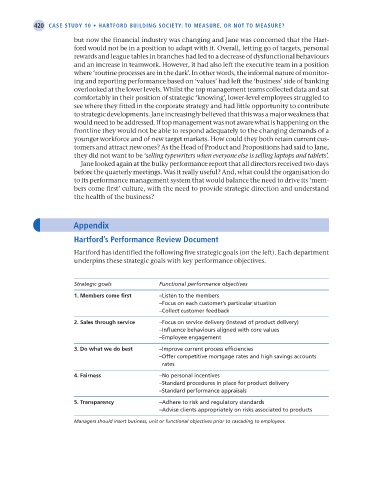Page 445 - Operations Strategy
P. 445
420 case study 10 • Hartford Building society: to measure, or not to measure?
but now the financial industry was changing and Jane was concerned that the Hart-
ford would not be in a position to adapt with it. Overall, letting go of targets, personal
rewards and league tables in branches had led to a decrease of dysfunctional behaviours
and an increase in teamwork. However, it had also left the executive team in a position
where ‘routine processes are in the dark’. In other words, the informal nature of monitor-
ing and reporting performance based on ‘values’ had left the ‘business’ side of banking
overlooked at the lower levels. Whilst the top management teams collected data and sat
comfortably in their position of strategic ‘knowing’, lower-level employees struggled to
see where they fitted in the corporate strategy and had little opportunity to contribute
to strategic developments. Jane increasingly believed that this was a major weakness that
would need to be addressed. If top management was not aware what is happening on the
frontline they would not be able to respond adequately to the changing demands of a
younger workforce and of new target markets. How could they both retain current cus-
tomers and attract new ones? As the Head of Product and Propositions had said to Jane,
they did not want to be ‘selling typewriters when everyone else is selling laptops and tablets’.
Jane looked again at the bulky performance report that all directors received two days
before the quarterly meetings. Was it really useful? And, what could the organisation do
to its performance management system that would balance the need to drive its ‘mem-
bers come first’ culture, with the need to provide strategic direction and understand
the health of the business?
appendix
Hartford’s Performance review document
Hartford has identified the following five strategic goals (on the left). Each department
underpins these strategic goals with key performance objectives.
Strategic goals Functional performance objectives
1. Members come first –Listen to the members
–Focus on each customer’s particular situation
–Collect customer feedback
2. Sales through service – Focus on service delivery (instead of product delivery)
–Influence behaviours aligned with core values
–Employee engagement
3. Do what we do best –Improve current process efficiencies
– Offer competitive mortgage rates and high savings accounts
rates
4. Fairness –No personal incentives
– Standard procedures in place for product delivery
–Standard performance appraisals
5. Transparency –Adhere to risk and regulatory standards
– Advise clients appropriately on risks associated to products
Managers should insert business, unit or functional objectives prior to cascading to employees.
Z10 Operations Strategy 62492.indd 420 02/03/2017 13:54

